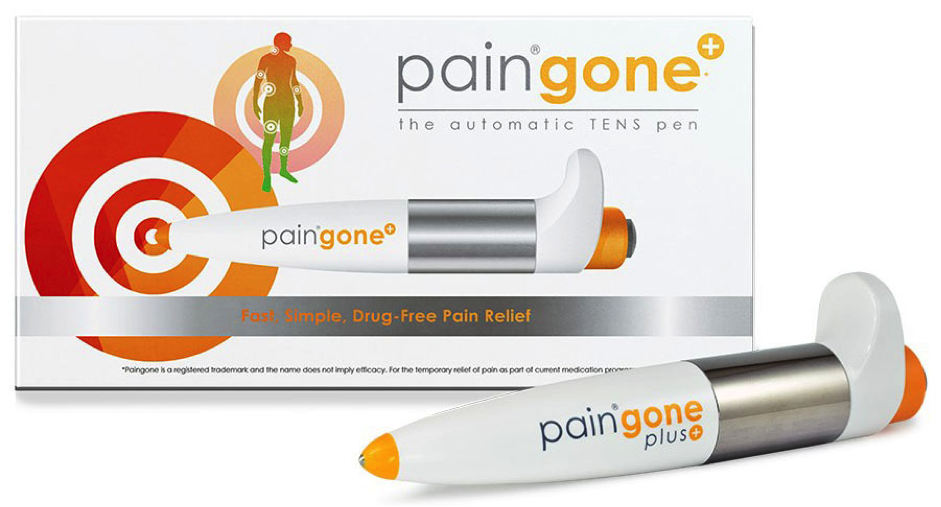
Monash University School of Public Health and Preventive Medicine research assistant Abdullah Sheriffdeen spent the summer of 2019 following up complaints sent to the Therapeutic Good Administration (TGA) which had been classified as ‘low risk’ and ‘closed’ by the regulator by sending a Regulatory Obligations letter to the advertiser. Complaints about Pain Erazor and the Pain®Gone pen were two pain-zapping products he reviewed.
Introduction
Pain can debilitate individuals and impinge on overall quality of life. Deloitte Access Economics reported that 3.24 million Australians were living with chronic pain last year, costing the country $73.2 billion dollars. There is also concern about overuse of opioid drugs for the relief of chronic pain. So, pens such as Pain®Gone and Pain Erazor that claim ‘fast effective, drug-free pain relief’ could be expected to sell well. It’s a great concept; place the pen on your skin, click the button a few times, and the pain will fade away. Or will it?
Complaints
In 2015, Pain®Gone had a complaint about its misleading claims upheld by the Therapeutic Goods Advertising Complaint Resolution Panel (TGACRP). In response, the advertiser (at that time uHealth Australia Pty Ltd) withdrew the promotion. In 2018 the product was promoted again by a different company (Au Remedial). On 15 July 2018 a new complaint (AC-KD45638R/2018) was sent to the Therapeutic Goods Administration (TGA),which had taken over advertising complaints from the TGACRP. The complainant argued that the numerous claims made (including the product name) lacked evidence to support them and breached many sections of the Therapeutic Goods Advertising Code. This complaint was given a ‘low-risk’ classification by the TGA and closed on 2 August 2018 after a Regulatory Obligations letter was sent to the advertiser. This was despite the TGA’s risk-based classification system which states that a case should be categorised as ‘medium-risk’ when it involves ongoing advertising breaches. Regardless, the product continued to be advertised on-line and yet another complaint was sent to the TGA pointing out the failure of their Regulatory Obligations letter to produce compliance.
In 2017, Pain Erazor was awarded a Choice ‘Shonky’ award and also had a complaint sent to the TGACRP. As this complaint was similar to the 2015 Pain®Gone complaint, the TGACRP referred it to the TGA for regulatory action. There is no record of any action having been taken by the TGA about this referral. Because of this, another complaint about this product was sent to the TGA on 3 August 2018 (AC-E7JS15BB/2018). Despite the documented past history, this complaint was also categorised as low risk by the TGA and closed on 24 September 2018, with a Regulatory Obligations letter sent to the advertisers. Regardless, the product continues to be advertised and yet another complaint has been sent to the TGA, pointing out the failure of their Regulatory Obligations letter to produce compliance. These complaints raise two general issues.
Classification of complaints and KPIs
The complaints described above were classed as ‘low-risk’ despite TGA guidelines stating that ongoing advertising breaches should be treated as ‘medium-risk’. ‘Low-risk’ complaints are closed by merely sending the advertiser a Regulatory Obligations letter and asking them to review their promotion. The letter also states that no further action will be taken. It is not surprising that sending such letters fails to achieve regulatory compliance.
For complaints classified as ’medium-risk’, the advertiser is sent a formal warning letter and asked to fix the breach within 14 days. An acceptable response closes the complaint. Over 90% of complaints dealt with by the TGA in 2018-19 were categorised as ‘low-priority’. Clearly, much less work is involved if complaints are classified as ‘low-priority’. It is also much easier for the TGA to meet their time-based Key Performance Indicators (KPIs) in this way. KPIs should be based on when compliance is achieved, not when a letter is sent.
Efficacy of transcutaneous electro neuronal stimulation (TENS)
There is controversy about the efficacy of transcutaneous electro neuronal stimulation (TENS) for chronic pain relief, especially pen-type devices such as Pain®Gone and Pain Erazor that use a single point electrode. The complainants found only one study cited to support these devices. It was low quality, unpublished, had a small sample size and was carried out by a contract research company on behalf of the device sponsor.
More conventional TENS devices use a small battery-operated unit to apply low-intensity electrical current to the body using two or more electrodes attached to the skin. A 2019 Cochrane review on the efficacy of TENS for chronic pain concluded that it was not possible to confidently state whether TENS was effective in relieving pain compared to sham TENS, usual care/no treatment or when TENS was combined with another active treatment versus the active treatment alone
Conclusion
So, can a few zaps a day keep the pain away? With the exception of a possible placebo response, the answer is no. The Prime Minister might say, ‘How good is the TGA!’. We say, ‘There is considerable room for improvement!’
